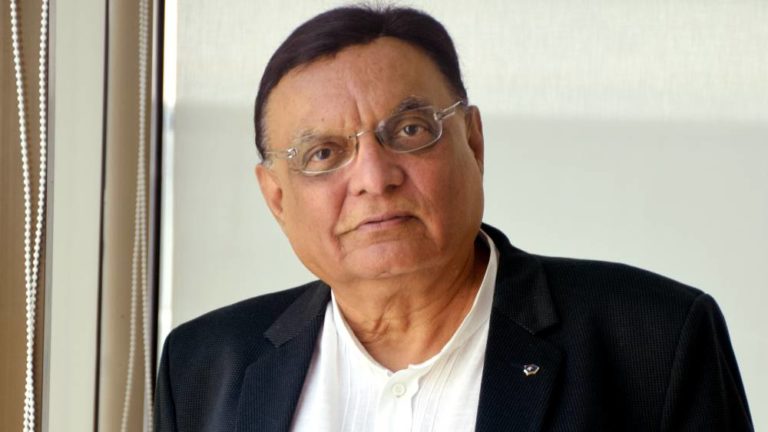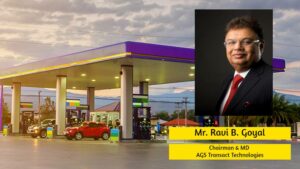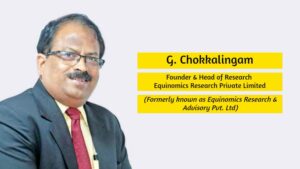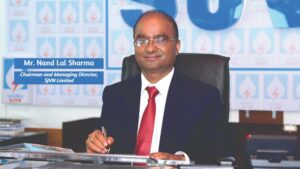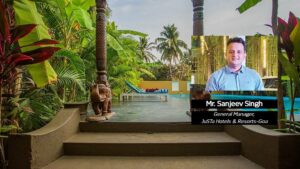Seldom has it happened that one meets a 71 year young man, with a to-do-list for another 50 years. Wearing experience and modesty on one sleeve and aggression and shrewdness on the other, when he speaks you listen not hear. All these four ingredients make a deadly combination to succeed in this cut throat competitive world. But it’s hard to have them in a proper composition. It’s in fact an art and learning an art is difficult. Even if one succeeds in acquiring all this, it is not easy to effectively experiment on those lines without a glint of vision. Mr. Rahul M. Timbadia fits in this groove very easily. Even Nostradamus will cringe in his grave if he gets to know him – the man who envisioned the future 20 years before it all happened.
Mr. Rahul M. Timbadia wears many hats. For someone who started his career in 70s successfully charting a path during those corrupt licence raj would certainly not have been an easy task, but he did and did with flying colours. Bungee jumping from the highly profitable metal trading to realty, then to hospitality and now ready to have another stint in agriculture is the way he has charted his life’s journey. A complete god-fearing family man he took the first two letters La from his mother’s name and Tim from his surname Timbadia. Thus was born the La Tim group and as the proverb goes, he never looked back.
Well-versed with different segments of the economy and a die-hard optimist with a twinkle in his eyes Mr Rahul M. Timbadia, Managing Director, La Tim Metal & Industries Ltd. spoke with Krishna Kumar Mishra about his journey, future plans, Covid, and its impact in detail.
“The best opportunities lie in tourism and agriculture”
A lot of disruptions happened in the entire segment of economy and industry in these critical times. What kind of crisis you faced and what has been the impact of Covid and lockdown on your business?
We’ve three verticals – steel, real estate and hospitality. The vertical that suffered the most due to Covid is hospitality. Not only in India, tourism industry was most affected all over the world as people didn’t venture out for most part of the year. Our two hotels in Mahabaleshwar and Malshej were completely shut down. All our restaurants were closed. In case of real estate the story is different as the market was already down right from 2013. However, contrary to our expectation and disbelief we found this sector followed a recovery path. There seems to be indeed some interest in real estate. Most of our investment in this sector is outside city and our main focus is creating a second home and the farmhouses and we are finding huge demand in that space. Our project in Khopoli-Pali road is receiving renewed buyer’s interest.
Third vertical as I mentioned is steel. Earlier when huge supply was coming from China this sector suffered a lot. Many companies failed and many promoters lost interest. Even big names like Essar and Uttam Steel could not survive the jolt. Thankfully the government at the right time put some restrictions on import as well as on quality and simultaneously many other countries also declared anti-dumping duty on China. Even some countries have gone to 300 per cent. Lastly imports from China considerably have reduced. Indian companies got huge support and as a result Jindal, Tata and Arceler Mittal group started their buying spree and bought many companies. Others like secondary steel manufacturers also got benefitted.
What is the current status of the Metal Sector?
Again I must appreciate the timely action taken by the government. In last week of March lockdown was announced but in May government allowed us to open up the shutters. Three factors played big role – import was restricted, domestic industries created demand and third, which is most important, the government gave green flag on big scale to many ambitious infrastructure projects be it in roads, ports, bridges or railways. The government announced many packages and released huge funds which suited steel sector. I can say from May 2020 the golden period of steel industry started and it continues. So on one side tourism industry suffered badly but steel got its much-needed reward. When first phase of Covid was over the tourism industry was coming back on track shortly the second wave again put a stop to that. Now the situation has improved a lot. I personally feel the bad phase of tourism industry is over. So all the three sectors we are operating in have bright future going forward. You may call it a blessing in disguise.
Is it?
Yes, steel is directly related to economic growth of the country so when the economy is marching ahead the sector automatically gets a boost. My personal observation is that whole country will be renewed. Everything will be first broken up and then constructed anew. Buildings, factories, bridges, airports, even new Parliament building is coming up – all are on the same renewal path. It is necessary and timely. When I visited China in 1993 it was already on the same line which was drawn there in 1973. I found it very energetic and vibrant. The same vibes I’m finding here. Our 1973 has just begun and after next 20 years we’ll be living in a new India. Already we can see this happening around us. Shining new Airports buildings are just an example. Cities like Indore, Hyderabad, Raipur and Ranchi are almost transformed. So future of metal sector is bright. Last one and half years have been quiet a satisfying journey for the entire steel industry.
Please elaborate the product line you have?
We manufacture colour-coated sheets which come in steel hierarchy at last. From iron ore to long and flat products, cold roll, GI and then comes PPGI (pre-painted galvanised steel). In this segment production volume is comparatively less. Even big companies don’t manufacture much because they get huge demand for hot rolled and cold rolled products. Compared to these two demand for colour-coated is less. Besides, the big companies are not interested in small quantities of designer products. And here enters the secondary steel manufacturer. The biggest advantage is they can cater to a particular segment in more efficient and cost-effective manner. Now as the import fear is out and raw material is easily available locally we can say the golden period of steel industry has arrived with a bang.
How is your business progressing?
We are into flat products which are mainly used in industries unlike the long products which are used in construction sector like angle, channel, beam and twisted/ round wire etc. Our product line is used in furniture, roofing, machinery and many capital goods. In flat products last come colour-coated sheets. Its future is very bright because it is a new entrant in steel industry. Everywhere around the world the use of colour-coated sheets is increasing manifold. In India it is slowly replacing the galvanised sheets. You get many shades of colours, designs which increase the aesthetic value of anything wherever used. Besides it increases the life span of the products. First cold rolled, then galvanised, then colour coated. So these processes make it all weather proof. Atmospheric effect is reduced to minimal. Our plan is to use galvalum which will slowly replace galvanised. Earlier it was zinc coating because it has healing quality that means if there is crack then the zinc will automatically cover it saving side effects of water etc. Cold roll is corroded easily but zinc is far better resistant. Using Zinc and aluminium alloy increases strength, it is lighter with more life span. So before integration, we have decided that instead of GI we’ll have a Galvalum plant in future and use cold roll sheets as raw material.
Why you import colour coated steel sheets?
One time Japan was the number one in steel industry. Then China overshadowed it in 20 years.
A situation came that in out of total steel production China’s share was a whopping 50 per cent. Despite this till 2003 China was the biggest importer of steel when the country hosted Olympics. Now China has reduced its production due to many reasons – less domestic demand, environmental issues, less demand coming from other countries, which again for obvious reasons. So it has created a vacuum. Now it will be not an easy task to fill that vacuum. But still China is number one producer and India comes next, at number two. Our domestic demand is increasing every day. World over huge fund is being allocated to infrastructure especially in developing countries. Many countries are on the growth path. Thus the demand is so huge India cannot fulfil. China still has monopoly over some products like thinner gauges. They are also very advanced in designs like 3D. These products are so beautiful one cannot easily identify whether it is steel or a painting or tiles. I don’t think those quality products Indian manufactures will produce in near future. So we import such products from China.
Please brief about your real estate division La Tim Lifestyle & Resorts.
I started my career in 1971 in steel sector after my graduation in science stream from Jai Hind College in Mumbai. Then I did LLB and also finished Diploma courses in ornithology and entomology because I was curious in nature. Till 1987 I was active as steel trader and for a period of 9 years was also Director of Bombay Iron Merchants Association. Those days steel market was being shifted from city to Kalamboli. CIDCO had allotted us 600 bungalow plots in New Panvel and 2000 warehousing plots in Kalamboli.
CIDCO had a very dynamic marketing manager Mr Sabnis who happened to be the father in law of well-known actor Sachin. His daughter Supriya is also a well-known actress. Being the chairman of our CIDCO committee I was coordinating with him and we gradually became friends. He used to tell me very enthusiastically about the plans and statistics of the governments for that area and how the government was keen to develop the area with facilities like new bridge, artist colony, educational institutes etc.
But how this shift came from steel to real estate?
As I said, when I visited the places offered by CIDCO I envisioned tremendous scope there. I convinced the members of our association to take the plots whether they intend to shift their business or not.
My logic was simple – when the government is investing so much what else we need? Those days India was facing big foreign exchange crisis. Steel was also a precious commodity, only registered dealers used to get it. Licence premium on import was very heavy. There was no factory of galvanised steel and I used to import. In India galvanised coating was done on hot roll which should have been done on CR. Even TISCO was doing the same. With all these issues facing the industry I was seriously thinking of changing my line.
And one fine day I sold most of my steel business and with lock, stock and barrel invested all in real estate. I bought 200 acres in Panvel, designed a Farm House scheme and started selling it under the brand name of Vrindavan Society. Farm House concept was completely new for Mumbai residents unlike Delhi and Bangalore. But to my astonishment it was sold like hot cake. Cricketer Dilip Vengsarkar, Paresh Rawal, Cine-writer Salim Khan became a member of the society and bought a plot, later Salman Khan bought bigger plot. From 1987 to 1997 there was a big boom in real estate. By the end of this period we were able to hold around 2000 acre land bank in our kitty scattered up to Dapoli. There are still so many restrictions on land development. So we decided to diversify.
And how La Tim Metal was born?
Drilco Metals Carbide Ltd. was Ahmadnagar-based listed company manufacturing metal-carbide tip with virtual monopoly with Siemens. But due to cheaper imports from China the company was in trouble, huge debt piled up and it got delisted. Its promoter Ramesh Khanna, a very intelligent man, was my friend, also a Rotarian. One day in 2010 he offered to sell the company. I visited the factory and since I was keen to have a steel factory I bought it. I shifted the factory to Umbergaon, Gujarat as I got tremendous support there. The electricity charge compared to Maharashtra was less. I revived the listed company, paid all the debts and changed its name. In fact we’ve four companies – La Tim Metal, Saj Hotels, La Tim Lifestyle & Resorts, and La Tim Sourcing India, where we used to import steel. Since Drilco had a weak balance sheet being shut for long time so in order to merge the company we first made it a 100 per cent subsidiary of La Tim Metals. Now we’ve applied to the concerned authorities to merge the same. After the merger we will have 3 companies.
How the idea of colour-coated sheets came?
In 2007 I visited China to know all about pre-fabricated houses. I saw wood designs which earlier only Japan and Germany were manufacturing. I collected samples, came back and enquired rates. Surprisingly, China vendor quoted half the price than Japan vendor. In India still no company was manufacturing it. In 2009 we started importing but later decided to enter the field as I saw huge scope in colour-coated sheets. But investing 100 crore was not a good idea without exploring the market. I decided we’ll keep importing till we reach 60,000 tonnes sale and then establish the factory. In 2013 we reached to that target and in 2018 we started manufacturing here itself in our own complex. Now since fear of China is no more we are going full blast.
Any plan to expand Hospitality business?
In 1997 we entered in hospitality sector. Our first project was Saj Hotel in Mahabaleshwar with 80 rooms which later we gave to Club Mahindra on 9 years lease rent. Saj Malshej was the second project which has 40 rooms and another 20 rooms are being added and the third was a hotel in Pench, 90 kilometres away from Nagpur, with 20 rooms and another 35 rooms are being added. The fourth is recently added in Goa with 27 rooms. We are running all the hotels except Mahabaleshwar property because I couldn’t say no to Mr Arun Nanda. I had been rejecting his offer but he called me for tea. It was his birthday and I agreed. It is a fantastic group headed by the best people in the industry. My son and nephew are more interested in hospitality sector. Both are well educated with modern outlook having done their post-graduation from abroad. They are looking after our group company Saj Hotels Pvt. Ltd. At present we have two restaurants also and have big plans of expansion.
And La Tim Lifestyles & Resorts?
La Tim Lifestyles & Resorts Ltd. is a separate company. The reason behind was the land we were buying was outside city periphery. I always knew that going forward in future two sectors are going to be the game changers – agriculture and tourism. Since I am a nature lover I have selectively purchased all the land. As the demand will come the land will go into that particular segment whether it is industrial use, agriculture, farm houses or resorts. You will love the natural landscape, the Sahyadri range, the clean virgin beaches, the flora and fauna.
You have supposedly a land bank in excess of 1000 acres so you must be having big plans to utilise this.
As I said earlier from 1987 to 1997 was the best time for real estate. From 1997 to 2003 it was a bad phase. Again it picked up till 2013. From 2013 the situation was bad but now it has taken a turnaround. Now I feel outside cities new areas will be developed like USA where near each big city there are towns with the same kind of infrastructure. The same is going to happen in India. In 2001 I was invited to attend a government seminar when they were planning the roadmap for 2011. The most ambitious plan discussed was the DMIC (Delhi Mumbai Industrial Corridor). It was supposed to be the biggest infrastructure plan. It was 4 in fact including Southern and Western Corridor. Government had started works also. I was simply mesmerised with the kind of planned developmental works.
The smartest move was taken by Mr Narendra Modi as CM when he signed up MOU with Japan and declared Dholera a smart city. All this made me think that the future lies not in Mumbai or Panvel but beyond that. So I concentrated far flung areas like Uran, Dapoli, Sindhudurg, Ratnagiri etc. Goa is too costly but in Sindhudurg you get an acre in Rs 15 lakh. Government has taken big steps to develop Sindhudurg. Airport is operational. We bought 25 acre land in Sindhudurg. The day it is developed as planned people will forget Goa. Beautiful beaches and wonderful people. In my opinion Indians don’t need to go out. We have so many beautiful places in each state.
Any new initiative that you wish to share?
I find agriculture very attractive. So my next plan after two years is to involve into farming. We have huge tract of land, around 700 acres, on Khopoli-Pali road. I feel the new technology and the new markets are going to change our age-old narrative regarding this sector. We have natural water, better environment, dedicated labour force, and to top it all a big domestic market. I’m also interested in food processing. I may look repetitive when I say this but really I see the best opportunities lie in tourism and agriculture.
How La Tim as a group is contributing in the government’s Aatmanirbhar Bharat Scheme?
We have to accept this hard fact that even today we are still dependent on others for many products and services. When I look back on China in 1976 and compare it with China in 2021 I can relate its growth, the lifestyle and the feel of independence with its one big achievement – it is self-reliant. China doesn’t need anything from outside and produces and manufactures everything that it needs. I think India too has all the inputs including the will and the skilled manpower. I find Prime Minister’s Aatmanirbhar Bharat slogan very powerful. It energizes and electrifies us. La Tim as a group is very much contributing in the efforts of the government in whatsoever field we are actively associated with.
“The country is changing and changing for good, and changing very fast. We see a new revolution. Being a colony India didn’t take part in the industrial revolution which changed the face of the entire world. But India did take part very aggressively during the IT revolution. Now Indians are on top in that. No one can beat them. Now the new generation is actively involved in all the segments, in each space wherever there are scopes. India will certainly be Aatmnirbhar and we all should actively contribute.”
La Tim Metal & Industries Ltd. Latim Metal And Industries Limited is a Mumbai-based BSE listed company incorporated on 28th January, 1975 and on 22nd August, 1975 it was converted into a Public Limited Company. Originally promoted by Mr. J.K. Khanna with 5 partners and in addition, SICOM and WMDC (West Maharashtra Development Corporation) were the co-promoters in the Company. In the year 2010, the Company was acquired by Mr. Rahul Timbadia and his family members and now they are the present promoters of the Company. The Company is mainly into the business of trading of color coated coils and profile sheets. The company’s expertise lies in providing end to end solutions which includes manufacturing products as per required specification to its customers. Providing right product for the right requirement at the right price is its motto. This has resulted in close ties with major customers within India.



